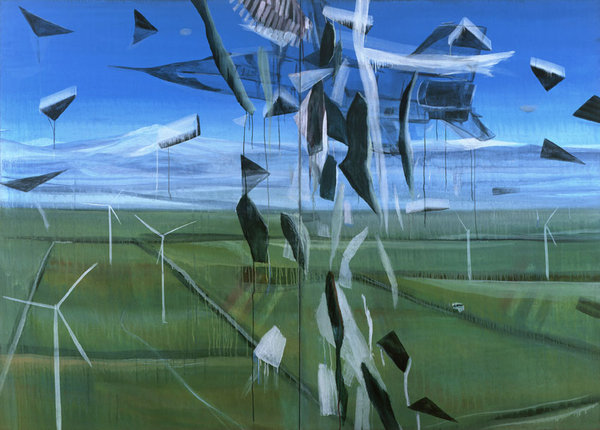Marc Desgrandchamps
dal 29/4/2010 al 18/6/2010
Segnalato da
29/4/2010
Marc Desgrandchamps
Galerie Zurcher, Paris
Fragments of a Random Modernism

This new exhibition by Marc Desgrandchamps, in contrast to its predecessors, is not characterised by unity; but the diversity of its themes actually highlights the persistence of certain principles.
There are "revenants", like that of the horse figure in the Suite Basserode (1), which resulted from a spatial exchange of random dimensions between Desgrandchamps and his fellow artist Basserode. "This entails a disruption," explains Desgrandchamps, "a deviation in my work, a way of devising another story within the translucent montage of my representations." And there are also new combinations, fragments of which belonged to previous identifiable ensembles, like the piece of cloth with its baroque decoration whose more or less incongruous presence, between one picture and another, is purely formal in function. But although the exhibition is not thematically homogeneous, it has a "core" that encapsulates the crucial question of "time" with clarity and precision. This is Nietzsche’s virtual centre, which is "everywhere and nowhere"(2). Desgrandchamps, who provided the title for the publication that accompanies the exhibition, Fragments d’un modernisme aléatoire ("Fragments of a random modernism"), interrogates the "modernist" period, which we know to have been very much a product of a world in crisis. And it is still far from over. The exhibition contains a large triptych that perfectly expresses this interrogation, which is expressed in a precise process. Richard Leydier’s text discusses the particular use Desgrandchamps makes of photography as a preliminary to painting, quoting from a lecture by the artist on photography "as a mnemonic, and an ordering of things seen, […] a two-dimensional filter between my perception and the world. It is a filter in that it retains all the interference produced by the sound, wind, dust, heat and humidity that submerge our senses when we are directly confronted with reality, and the way we are thrust into life."(3) This idea was further reinforced by a remark the artist made one day in conversation. Looking at photographic reportages of war situations (and notably the Balkans), he told me how on several occasions he had been struck by the fact that the worst atrocities were committed under magnificent blue skies like those of touristy snapshots. Since then, he has felt that such skies can seem as threatening as aeroplanes laden with bombs. And indeed it is not rare for the two to appear in the same painting.
The always-identical blocks of blue, unmodulated but sometimes traversed by cloudy white stripes, without relief, pass from one painting to another in a wholly natural way. With their petrifying light, they set their stamp on the most minor scenes. The figures – architecture or landscapes comprised of fragments derived from compositions that may go back several years (for example cactus shapes against a background of snow-covered mountains) – are plunged in a timeless universe whose components, though figurative, are also indeterminate. This is an effective link between the different parts of an oeuvre – that of Marc Desgrandchamps – whose perceptual "totality" is independent of the viewpoint from which one approaches it. Bernard Zürcher
(1) Previously exhibited in Détournement réciproque (with Basserode), at the Espace François-Auguste Ducros, Grignan, 27 September – 8 November 2009.
(2) In Thus Spake Zarathustra, 1885.
(3) In "Le Retour de la Gradiva", in the catalogue, Paris, Editions Liénart, March 2010.
Image: Sans titre, 2009 - diptyque
Galerie Zürcher
56, rue Chapon F-75003 Paris
Open: Tues-Sat 12pm - 7pm



